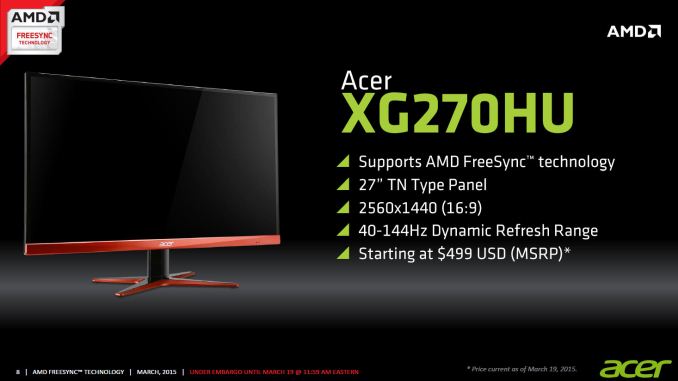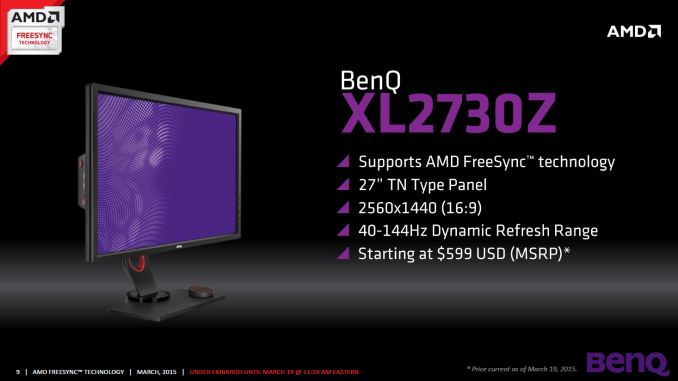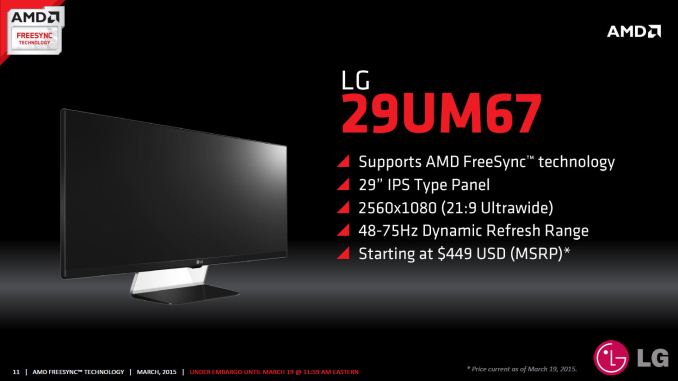The AMD FreeSync Review
by Jarred Walton on March 19, 2015 12:00 PM ESTFreeSync Displays
There are four FreeSync displays launching today, one each from Acer and BenQ, and two from LG. Besides the displays launching today, seven additional displays should show up in the coming weeks (months?). Here’s the current list of FreeSync compatible displays, with pricing where it has been disclosed.
| FreeSync Compatible Displays | ||||||
| Manufacturer | Model | Diagonal | Resolution | Refresh | Panel | Price |
| Acer | XG270HU | 27" | 2560x1440 | 40-144Hz | TN | $499 |
| BenQ | XL2730Z | 27" | 2560x1440 | 40-144Hz | TN | $599 |
| LG Electronics | 34UM67 | 34" | 2560x1080 | 48-75Hz | IPS | $649 |
| LG Electronics | 29UM67 | 29" | 2560x1080 | 48-75Hz | IPS | $449 |
| Nixeus | NX-VUE24 | 24" | 1920x1080 | 144Hz | TN | ? |
| Samsung | UE590 | 28" | 3840x2160 | 60Hz | TN | ? |
| Samsung | UE590 | 23.6" | 3840x2160 | 60Hz | TN | ? |
| Samsung | UE850 | 31.5" | 3840x2160 | 60Hz | TN? | ? |
| Samsung | UE850 | 28" | 3840x2160 | 60Hz | TN? | ? |
| Samsung | UE850 | 23.6" | 3840x2160 | 60Hz | TN? | ? |
| Viewsonic | VX2701mh | 27" | 1920x1080 | 144Hz | TN | ? |
The four displays launching today cover two primary options. For those that want higher refresh rates, Acer and BenQ have TN-based 40-144Hz displays. Both are 27” WQHD displays, so it’s quite probable that they’re using the same panel, perhaps even the same panel that we’ve seen in the ASUS ROG Swift. The two LG displays meanwhile venture out into new territory as far as adaptive refresh rates are concerned. LG has both a smaller 29” and a larger 34” 2560x1080 (UW-UXGA) display, and both sport IPS panels (technically AU Optronics' AHVA, but it's basically the same as IPS).
The other upcoming displays all appear to be using TN panels, though it's possible Samsung might offer PLS. The UE590 appears to be TN for certain, with 170/160 degree viewing angles according to DigitalTrends. The UE850 on the other hand is targeted more at imaging professionals, so PLS might be present; we'll update if we can get any confirmation of panel type.
One of the big benefits with FreeSync is going to be support for multiple video inputs – the G-SYNC displays so far are all limited to a single DisplayPort connection. The LG displays come with DisplayPort, HDMI, and DVI-D inputs (along with audio in/out), and the Acer is similarly equipped. Neither one has any USB ports, though the BenQ does have a built-in USB hub with ports on the side.
Our testing was conducted on the 34UM67, and let me just say that it’s quite the sight sitting on my desk. I’ve been bouncing between the ASUS ROG Swift and Acer XB280HK for the past several months, and both displays have their pros and cons. I like the high resolution of the Acer at times, but I have to admit that my aging eyes often struggle when running it at 4K and I have to resort to DPI scaling (which introduces other problems). The ASUS on the other hand is great with its high refresh rates, and the resolution is more readable without scaling. The big problem with both displays is that they’re TN panels, and having come from using a 30” IPS display for the past eight years that’s a pretty painful compromise.
Plopping the relatively gigantic 34UM67 on my desk is in many ways like seeing a good friend again after a long hiatus. “Dear IPS (AHVA), I’ve missed having you on my desktop. Please don’t leave me again!” For the old and decrepit folks like me, dropping to 2560x1080 on a 34” display also means reading text at 100% zoom is not a problem. But when you’re only a couple feet away, the relatively low DPI does make the pixels much more visible to the naked eye. It even has built-in speakers (though they’re not going to compete with any standalone speakers in terms of audio quality).
The launch price of $649 is pretty impressive; we’ve looked at a few other 21:9 displays in the past, and while the resolution doesn’t match LG’s 34UM95, the price is actually $50 less than the LG 34UM65’s original $699 MSRP (though it’s now being sold at $599). So at most, it looks like putting in the new technology to make a FreeSync display costs $50, and probably less than that. Anyway, we’ll have a full review of the LG 34UM67 in the coming weeks, but for now let’s return to the FreeSync discussion.
Pricing vs. G-SYNC
It certainly appears that AMD and their partners are serious about pricing FreeSync aggressively, though there aren’t direct comparisons available for some of the models. The least expensive FreeSync displays start at just $449, which matches the least expensive G-SYNC display (AOC G2460PG) on price but with generally better specs (29” 2560x1080 and IPS at 75Hz vs. 24” 1920x1080 TN at 144Hz). Looking at direct comparisons, the Acer XG270HU and BenQ XL2730Z are WQHD 144Hz panels, which pits them against the $759 ASUS ROG Swift that we recently reviewed, giving FreeSync a $160 to $260 advantage. As AMD puts it, that’s almost enough for another GPU (depending on which Radeon you’re using, of course).
Based on pricing alone, FreeSync looks poised to give G-SYNC some much needed competition. And it’s not just about the price, as there are other advantages to FreeSync that we’ll cover more on the next page. But for a moment let’s focus just on the AMD FreeSync vs. NVIDIA G-SYNC ecosystems.
Right now NVIDIA enjoys a performance advantage over AMD in terms of GPUs, and along with that they currently carry a price premium, particularly at the high end. While the R9 290X and GTX 970 are pretty evenly matched, the GTX 980 tends to lead by a decent amount in most games. Any users willing to spend $200 extra per GPU to buy a GTX 980 instead of an R9 290X might also be willing to pay $200 more for a G-SYNC compatible display. After all, it’s the only game in town for NVIDIA users right now.
AMD and other companies can support FreeSync, but until – unless! – NVIDIA supports the standard, users will be forced to choose between AMD + FreeSync or NVIDIA + G-SYNC. That’s unfortunate for any users that routinely switch between AMD and NVIDIA GPUs, though the number of people outside of hardware reviewers that regularly go back and forth is miniscule. Ideally we’d see one standard win out and the other fade away (i.e. Betamax, HD-DVD, etc.), but with a one year lead and plenty of money invested it’s unlikely NVIDIA will abandon G-SYNC any time soon.
Prices meanwhile are bound to change, as up to now there has been no competition for NVIDIA’s G-SYNC monitors. With FreeSync finally available, we expect prices for G-SYNC displays will start to come down, and in fact we’re already seeing $40-$125 off the original MSRP for most of the G-SYNC displays. Will that be enough to keep NVIDIA’s proprietary G-SYNC technology viable? Most likely, as both FreeSync and G-SYNC are gamer focused more than anything; if a gamer prefers NVIDIA, FreeSync isn’t likely to get them to switch sides. But if you don’t have any GPU preference, you’re in the market for a new gaming PC, and you’re planning on buying a new monitor to go with it, R9 290X + FreeSync could save a couple hundred dollars compared to GTX 970 + G-SYNC.
There's something else to consider with the above list of monitors as well: four currently shipping FreeSync displays exist on the official day of launch, and Samsung alone has five more FreeSync displays scheduled for release in the near future. Eleven FreeSync displays in the near term might not seem like a huge deal, but compare that with G-SYNC: even with a one year lead (more or less), NVIDIA currently only lists six displays with G-SYNC support, and the upcoming Acer XB270HU makes for seven. AMD also claims there will be 20 FreeSync compatible displays shipping by the end of the year. In terms of numbers, then, DP Adaptive Sync (and by extension FreeSync) look to be winning this war.


























350 Comments
View All Comments
JarredWalton - Friday, March 20, 2015 - link
FYI, ghosting is a factor of the display and firmware, not of the inherent technology. So while it's valid to say, "The LG FreeSync display has ghosting..." you shouldn't by extension imply FreeSync in and of itself is the cause of ghosting.chizow - Friday, March 20, 2015 - link
So are you saying a firmware flash is goiing to fix this, essentially for free? Yes that is a bit of a troll but you get the picture. Stop making excuses for AMD and ask these questions to them and panel makers, on record, for real answers. All this conjecture and excuse-making is honestly a disservice to your readers who are going to make some massive investment (not really) into a panel that I would consider completely unusable.You remember that Gateway FPD2485W that you did a fantastic review of a few years ago? Would you go back to that as your primary gaming monitor today? Then why dismiss this problem with FreeSync circa 2015?
chizow - Friday, March 20, 2015 - link
Who said no ghosting? lol. There's lots of ghosting, on the FreeSync panels.TheJian - Sunday, March 22, 2015 - link
You're assuming gsync stays the same price forever. So scalers can improve pricing (in your mind) to zero over time, but NV's will never shrink, get better revs etc...LOL. OK. Also you assume they can't just lower the price any day of the week if desired. Microsoft just decided to give away Windows 10 (only to slow android but still). This is the kind of thing a company can do when they have 3.7B in the bank and no debt (NV, they have debt but if paid off, they'd have ~3.7b left). They could certainly put out a better rev that is cheaper, or subsidize $50-100 of it for a while until they can put out a cheaper version just to slow AMD down.They are not equal. See other site reviews besides and AMD portal site like anandtech ;)
http://www.pcper.com/reviews/Displays/AMD-FreeSync...
There is no lic fee from NV according to PCper.
"It might be a matter of semantics to some, but a licensing fee is not being charged, as instead the vendor is paying a fee in the range of $40-60 for the module that handles the G-Sync logic."
Which basically shows VENDORS must be marking things up quite a lot. But that is too be expected with ZERO competition until this week.
"For NVIDIA users though, G-Sync is supported on GTX 900-series, 700-series and 600-series cards nearly across the board, in part thanks to the implementation of the G-Sync module itself."
Not the case on the AMD side as he says. So again not so free if you don't own a card. NV people that own a card already are basically covered, just buy a monitor.
Specs of this is misleading too, which anandtech just blows by:
"The published refresh rate is more than a bit misleading. AMD claims that FreeSync is rated at 9-240 Hz while G-Sync is only quoted at 30-144 Hz. There are two issues with this. First, FreeSync doesn’t determine the range of variable refresh rates, AdaptiveSync does. Second, AMD is using the maximum and minimum refresh range published by the standards body, not an actual implementation or even a planned implementation from any monitor or display. The 30-144 Hz rating for G-Sync is actually seen in shipping displays today (like the ASUS PG278Q ROG Swift). The FreeSync monitors we have in our office are either 40-144 Hz (TN, 2560x1440) or 48-75 Hz (IPS, 2560x1080); neither of which is close to the 9-240 Hz seen in this table."
Again, read a site that doesn't lean so heavily to AMD. Don't forget to read about the GHOSTING on AMD. One more point, PCper's conclusion:
"My time with today’s version of FreeSync definitely show it as a step in the right direction but I think it is far from perfect."
"But there is room for improvement: ghosting concerns, improving the transition experience between VRR windows and non-VRR frame rates and figuring out a way to enable tear-free and stutter-free gaming under the minimum variable refresh rate."
"FreeSync is doing the right things and is headed in the right direction, but it can’t claim to offer the same experience as G-Sync. Yet."
Ok then...Maybe Freesync rev2 gets it right ;)
soccerballtux - Friday, March 20, 2015 - link
you must be a headcase or, more likely, are paid for by NVidia to publicly shill. Gsync requires a proprietary NVidia chip installed in the monitor that comes from, and only from, NVidia.It's much easier to simply set a flag-byte in the DisplayPort data stream that says "ok render everything since the last render you rendered, now". There's nothing closed about that.
chizow - Friday, March 20, 2015 - link
And? Who cares if it results in a better solution? LOL only a headcase or a paid AMD shill would say removing hardware for a cheaper solution that results in a worst solution is actually better.soccerballtux - Friday, March 20, 2015 - link
wellll, if it's cheaper and a better solution, then the market cares.chizow - Friday, March 20, 2015 - link
Except its cheaper and worst, therefore it should be cheaperbloodypulp - Friday, March 20, 2015 - link
Oh darn... so what you're saying is that I have to purchase the card that costs less, then I have to purchase the monitor that costs less too? Sound like a raw deal... ROFL!!And as far as your bogus oppenness argument goes: There is nothing preventing Nvidia from supporting Adaptive Sync. NOTHING. Well, unless you count hubris and greed. In fact, Mobile G-Sync already doesn't even require the module! I guess that expensive module really wasn't necessary after all...
And lastly, Nvidia has no x86 APU to offer, so they can't offer what AMD can with their Freesync-supporting APUs. Nvidia simply has nothing to compete with there. Even gamers on a tight budget can enjoy Freesync! The same simply cannot be said for GSync.
Denithor - Friday, March 20, 2015 - link
ONLY closed because NVIDIA refuses to support freesync. Much like OpenCL. And PhysX.